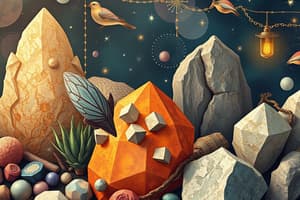Podcast
Questions and Answers
What makes up the Earth's crust?
What makes up the Earth's crust?
- Minerals and rocks (correct)
- Metals and rocks
- Soil and minerals
- Minerals and organic matter
Which term describes rocks that solidify at the Earth’s surface?
Which term describes rocks that solidify at the Earth’s surface?
- Intrusive igneous rocks
- Extrusive igneous rocks (correct)
- Coarse-grained rocks
- Sedimentary rocks
What is crystallization in the context of igneous rocks?
What is crystallization in the context of igneous rocks?
- Forming rocks from sand
- Melting of existing minerals
- Growing crystals from molten rock (correct)
- Erosion of existing rocks
How are igneous rocks classified based on formation?
How are igneous rocks classified based on formation?
What is a characteristic of coarse-grained igneous rocks?
What is a characteristic of coarse-grained igneous rocks?
Which minerals are typically found in igneous rocks?
Which minerals are typically found in igneous rocks?
Which type of igneous rock is formed from volcanic activity?
Which type of igneous rock is formed from volcanic activity?
What distinguishes medium-grained igneous rocks?
What distinguishes medium-grained igneous rocks?
Flashcards are hidden until you start studying
Study Notes
Earth’s Crust Composition
- The Earth’s crust consists of minerals and rocks.
- Minerals are individual crystals, while rocks are combinations of various minerals.
Rocks Overview
- Rocks are naturally occurring materials made up of minerals.
- Classified into three main types: Igneous, Metamorphic, and Sedimentary.
- The rock cycle illustrates how different types of rocks transform through geological processes.
Igneous Rocks
- Formed from solidified magma or lava; the term originates from the Latin “ignis,” meaning fire.
- Result from volcanic activity, with magma cooling and solidifying over time.
- Major elements in igneous rocks include Si (Silicon), O (Oxygen), Al (Aluminum), Ca (Calcium), Na (Sodium), K (Potassium), Mg (Magnesium), and Fe (Iron).
Crystallization
- Defined as the formation and growth of a crystalline solid from molten rock.
- Can occur underground or on the surface following a volcanic eruption.
Types of Igneous Rocks by Origin
- Extrusive Igneous Rocks (Volcanic Rocks): Formed when molten rocks solidify at the Earth's surface.
- Intrusive Igneous Rocks (Plutonic Rocks): Formed from magma cooling at greater depths within the Earth.
Types of Igneous Rocks by Texture
- Coarse-Grained: Crystals are visible to the naked eye, typically intrusive igneous rocks.
- Medium-Grained: Crystals can only be seen with a hand lens.
- Fine-Grained: Crystals are microscopic; requires a microscope for observation.
Studying That Suits You
Use AI to generate personalized quizzes and flashcards to suit your learning preferences.




